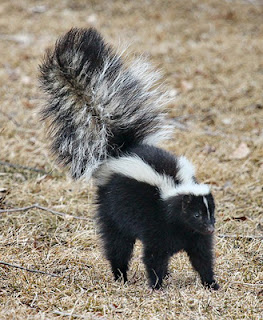But that's not necessarily the end of the story. Many animals cache a proportion of their food, saving it for later. One immediately thinks, perhaps, of squirrels storing their nuts so that they can come back to them in winter when food is in short supply. Many burrowing rodents do something similar, hoarding food in underground chambers that can return to at their leisure. But carnivores can cache food, too, despite the fact that meat tends to go off more quickly than properly stored nuts or grain.
Sunday, 23 July 2023
A Puma's Larder
Sunday, 16 July 2023
The Stinky Family: Skunks
Sunday, 9 July 2023
Oligocene (Pt 3): From Musk Deer to Hell-Pigs
 |
| Entelodon |
These include the gelocids, which first appeared close to the end of the previous epoch. Few of the known fossils of these animals are in good condition, and there is some debate as to whether they are a true group of animals at all, or just a vague term used to collect similar-looking creatures that we can't place elsewhere. That aside, we can at least say that they physically resembled (but were probably not related to) musk deer. That is, they were relatively small, hornless animals with long legs suited for running fast, but lacking the large fang/tusks that mark true musk deer. They did well enough that some, such as Pseudogelocus, are known not only from France and Germany, but also Mongolia, suggesting that they crossed over in the opposite direction to most other mammal groups.
Sunday, 2 July 2023
The Sex Lives of Female Jaguars
Monogamy is somewhat less common. Sometimes, it happens only because the species is sufficiently widespread that any given male is unlikely to find more than one receptive female during the breeding season, but it can also occur by choice, typically where raising young is a sufficiently arduous task that the father has to stay around after the birth to help. This is commonly associated with birds, but many mammals also form pair bonds for raising young. These include species of gibbon and small antelope that, in paternity tests, have shown essentially 100% loyalty to their mates. The prairie vole is well-studied in this regard, with the formation of the pair bond through prolonged and repeated mating having been linked to, among other things, the "cuddle hormone" oxytocin.
.jpg)

